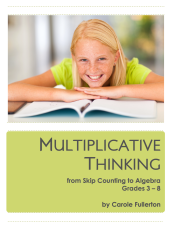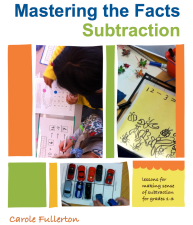NEW Resource! Proportional Reasoning in Grades 4-8
 For those who have been patiently waiting (and lovingly nagging!) I am happy to announce the publication of my newest math teaching resource: Proportional Reasoning in Intermediate for Grades 4-8, available now through my online store.
For those who have been patiently waiting (and lovingly nagging!) I am happy to announce the publication of my newest math teaching resource: Proportional Reasoning in Intermediate for Grades 4-8, available now through my online store.
This resource for teachers of Grades 4 to 8 presents more than 250 pages of open-ended lessons, meaningful practice, games, literature connections and a wealth of problem-solving contexts for supporting students to make sense of fractions, decimals, percentages, ratios and proportions. Designed for today’s diverse classrooms, this resource offers a range of tasks to promote proportional thinking through intentional development of mathematical language and the use of key manipulatives. Colour tiles, Cuisenaire rods and tangrams are used to model and make connections within and between concepts.
In the first section of the resource, students will explore three models – set, area and linear – for representing and describing, comparing and ordering fractions. Students will learn to convert between fractions, decimals and percent and to apply these skills to problem situations, including measurement, tax, discounts and data management. Next, students learn to add and subtract fractions, to solve proportions using a range of strategies (involving both mental math and the appropriate use of technology) and then finally to multiply and divide fractions.
Assessment tools are threaded throughout the resource to allow teachers to keep track of student progress and to make instructional decisions.
Proportional reasoning IS the math we do every day. This resource provides an access point for all.
Enjoy!
Maintenant disponible en français!
Finally … French translations of my latest books are now available!
Je viens de traduire mes deux ressources de bonnes questions — “A Year of Good Questions for Grades 2-4” et “A Year of Good Questions for grades 5-8” — afin que mes collègues d’immersion aient des ressources françaises avec lesquelles travailler. Merci pour vôtre patience!
In these new French translations of the English originals, you’ll find more than 200 open-ended and engaging problems for french immersion students from primary through middle school. All are posed in French and explore important mathematical concepts across the grades.
 The first book: Bonnes Questions: Une année de bonnes tâches mathématiques pour les élèves de 2e à 4e is suitable for late primary students (grades 2-4) and features operational tasks, measurement tasks and pattern tasks of increasing complexity, posed in French.
The first book: Bonnes Questions: Une année de bonnes tâches mathématiques pour les élèves de 2e à 4e is suitable for late primary students (grades 2-4) and features operational tasks, measurement tasks and pattern tasks of increasing complexity, posed in French.
 The second volume: Bonnes Questions: Une année de bonnes tâches mathématiques pour les élèves de 5e à 8e is perfect for middle school immersion students (grades 5-8), with a focus on proportional reasoning, algebraic thinking as well as operations on integers, fractions and decimals to name a few.
The second volume: Bonnes Questions: Une année de bonnes tâches mathématiques pour les élèves de 5e à 8e is perfect for middle school immersion students (grades 5-8), with a focus on proportional reasoning, algebraic thinking as well as operations on integers, fractions and decimals to name a few.
Engaging problems and choice make these volumes the perfect conversation starter for our immersion classrooms, promoting oral language development and mathematical thinking …en même temps!
All are available from my online store.
Carole
New For Primary! Good Questions: A Year of Open-Ended Problems for Grades 2-4
For those of you who have been waiting ever so  patiently, I wanted to let you know that I have completed a primary companion to the Year of Good Questions for Grades 5-8 resource released this summer.
patiently, I wanted to let you know that I have completed a primary companion to the Year of Good Questions for Grades 5-8 resource released this summer.
A Year of Good Questions for Grades 2-4 is the late primary version of this stand up calendar of problems — one for every day of the school year!
Like its intermediate counterpart, this compact but potent book comes with an easel so you can set it up on your desk and flip from one rich problem to the next, posing open-ended questions of your primary students.

Good Questions: A Year of Open-Ended Math Problems for Grades 2-4 is a problem-a-day resource that includes rich tasks ideal for grades 2, 3 and 4. Organized by topic and structured in problem sets of 5, this simple to use teacher resource includes 200 mathematically important questions to engage your students in deep thinking. For only $25, it’s a reasonably priced way to stimulate and promote mathematical conversation!
Operations, measurement, proportional thinking and patterns are featured in this calendar of problems. Each one engages students in thinking flexibly, critically and creatively to solve tasks of varying complexity.
Visit my online store at mindfull.ecwid.com to order.
Let the fun begin!
Carole
Good Questions: A Year of Open-Ended Problems for Grades 5-8
I am pleased to say that — beyond spending every day on the water this summer — I DID manage to create a new teacher resource for my intermediate colleagues.
This time, it’s a stand up calendar of problems — one for every day of the school year!
This compact but potent book comes with an easel so you can set it up on your desk and flip from one rich problem to the next, posing open-ended questions of your intermediate students.

Good Questions: A Year of Open-Ended Tasks is a problem-a-day resource that includes
rich tasks ideal for grades 5, 6, 7 and 8. Organized by topic and structured in problem sets of 5 or more, this simple to use teacher resource includes 210 mathematically important questions to engage your students in deep thinking. For only $25, it’s a perfect back-to-school gift for yourself!
Proportional reasoning, measurement, operations and algebra are featured in this calendar of problems. Each one engages students in thinking flexibly, critically and creatively in the face of important and challenging mathematics.
Visit my online store at mindfull.ecwid.com to order.
Let the problem-solving begin!
Carole
Print Resources for Teaching Number Sense
 For those of you who have been looking for some of the teacher resources and student materials that I have used in my demonstration lessons, I’ve opted to try and put a collection of them all in one post… This collection of materials are intended for teaching place value, for use in lessons involving partitioning (addition, subtraction and multiplication), for comparing and ordering whole numbers as well as decimals, and for the teaching of fractions. As you’ve seen modelled in the lessons I’ve taught, these materials work best in concert with visuals (ten frames, base ten blocks, etc) and with plenty of opportunities for students to write equations, describe their thinking orally, build with models and create real-world situations to match.
For those of you who have been looking for some of the teacher resources and student materials that I have used in my demonstration lessons, I’ve opted to try and put a collection of them all in one post… This collection of materials are intended for teaching place value, for use in lessons involving partitioning (addition, subtraction and multiplication), for comparing and ordering whole numbers as well as decimals, and for the teaching of fractions. As you’ve seen modelled in the lessons I’ve taught, these materials work best in concert with visuals (ten frames, base ten blocks, etc) and with plenty of opportunities for students to write equations, describe their thinking orally, build with models and create real-world situations to match.
The money and Cuisenaire Rods are best printed in colour, of course. I’d recommend sending the pdf’s to Staples.ca for printing. You can specify the weight of the paper (I like 80lb gloss cover) – and they’ll have the materials ready quickly for a reasonable price.
Consider putting magnetic tape on the back of these materials to allow them to be displayed on the white board. Check out the dispenser of magnetic tape available from Poster Pals. It’s great stuff!
I hope these prove helpful.
Happy teaching!
Carole
Place Value Tents – 100’s 10’s 1’s
Canadian 100 dollar bills large
Canadian 10 dollar bills large
Canadian loonies in ten frames
Cuisenaire rods ROCK.
 Here are some of my favourite Cuisenaire rod tasks for elementary. There are so many cool things to be done with these materials, I can’t begin to delve into it all here, but start with some of these ideas and see what kinds of thinking your students come up with. Remember it’s critical to record the numbers to accompany with your students’ constructions – modelling for them how a mathematician would record their reasoning is so very important. It allows students to formalize their learning and make connections to the “naked math”… (A phrase a dear friend of mine used to use often. Attention-getting, no??)
Here are some of my favourite Cuisenaire rod tasks for elementary. There are so many cool things to be done with these materials, I can’t begin to delve into it all here, but start with some of these ideas and see what kinds of thinking your students come up with. Remember it’s critical to record the numbers to accompany with your students’ constructions – modelling for them how a mathematician would record their reasoning is so very important. It allows students to formalize their learning and make connections to the “naked math”… (A phrase a dear friend of mine used to use often. Attention-getting, no??)
 As well, I’ve uploaded are some Cuisenaire provocations — images to inspire creativity that your younger students may enjoy. To keep the play moving mathematically, try placing one or more of these pictures at the table where students are exploring the materials. You can suggest they might like to try making something like the image, but it’s much more interesting to simply place the image on the table and walk away. Your students will no doubt do something with the picture – and it’s oh-so-fun to observe them in action!
As well, I’ve uploaded are some Cuisenaire provocations — images to inspire creativity that your younger students may enjoy. To keep the play moving mathematically, try placing one or more of these pictures at the table where students are exploring the materials. You can suggest they might like to try making something like the image, but it’s much more interesting to simply place the image on the table and walk away. Your students will no doubt do something with the picture – and it’s oh-so-fun to observe them in action!
Look around your school for Cuisenaire rods – it’s not unusual to find them stashed away in a cupboard somewhere, forgotten. They are a classic manipulative and one with great possibilities. If you find them and want to figure out ways to use them, don’t hesitate to contact me. I’d be happy to provide a workshop for your school staff, or to do a series of demonstration lessons with students across the grades with these versatile materials.
My favourite place to order Cuisenaire rods is through Spectrum Educational. Be sure to get the wooden materials only – they truly demonstrate the relationships in the most compelling way. Here’s a link to a class set of wooden materials from their on-line catalogue. For those of you in the lower mainland of BC, be sure to call Collins Educational — or drop by to pick some up. They’re always happy to help.
Enjoy a lovely weekend.
Carole








